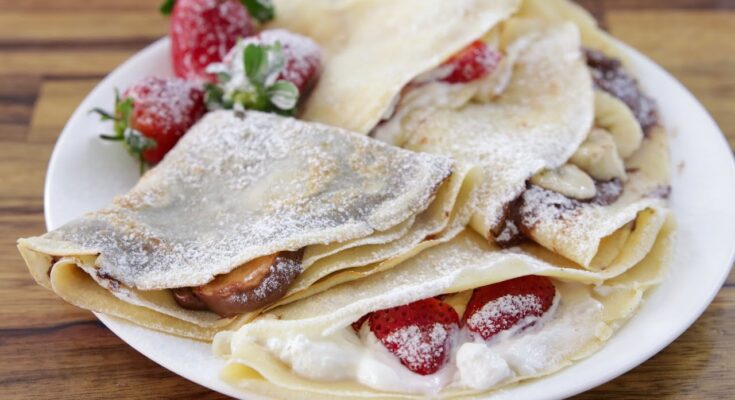Basic Crepe Recipe: Crepes are one of the most versatile and delightful dishes you can create in your kitchen. These thin, delicate pancakes originated in France but have gained worldwide popularity due to their simplicity and adaptability. Whether you’re in the mood for something sweet or savory, crepes can be customized to suit any craving.
But what makes crepes so special? Unlike thicker pancakes, crepes have a smooth, melt-in-your-mouth texture. They can be enjoyed at any time of day—breakfast, brunch, lunch, or even dessert. With endless possibilities for fillings and toppings, crepes are an irresistible treat for any occasion.
Ready to learn how to make them? Let’s dive into this step-by-step guide to mastering the perfect crepe recipe.
Ingredients for Basic Crepe Recipe
Main Ingredients Needed
To make classic crepes, you only need a few simple ingredients, most of which are already in your pantry:
- 1 cup (120g) of all-purpose flour – Provides structure and texture.
- 2 large eggs – Acts as a binding agent and adds richness.
- 1 ½ cups (360ml) of milk – Creates a smooth and pourable batter.
- 2 tablespoons of melted butter – Adds flavor and prevents sticking.
- 1 tablespoon of granulated sugar – Enhances sweetness (optional for savory crepes).
- 1/2 teaspoon of salt – Balances flavor.
- 1 teaspoon of vanilla extract – Adds a pleasant aroma (optional for sweet crepes).
Optional Add-ons for Flavor
- Cinnamon or nutmeg for a hint of spice.
- Cocoa powder for chocolate crepes.
- Orange or lemon zest for a citrusy touch.
These ingredients are easily adaptable depending on whether you prefer your crepes sweet or savory.
Essential Tools and Equipment
Before you start, having the right tools can make the process easier and more enjoyable.
Cooking Utensils Required
- Mixing Bowls – For combining and whisking ingredients.
- Whisk or Blender – To create a lump-free batter.
- Ladle or Measuring Cup – For pouring the batter into the pan.
- Spatula – For flipping crepes without tearing them.
Best Pans for Making Crepes
- Non-stick Frying Pan – Prevents crepes from sticking and burning.
- Crepe Pan (Optional) – Specially designed with low edges for easy flipping.
- Griddle Pan – Suitable for making larger crepes.
Step-by-Step Instructions for Making Crepes
Step 1: Preparing the Batter
- Mix Dry Ingredients – In a large bowl, sift the flour and add sugar and salt.
- Add Wet Ingredients – Create a well in the center and add eggs. Slowly pour in the milk while whisking continuously.
- Incorporate Butter and Flavoring – Stir in melted butter and vanilla extract (if making sweet crepes).
- Blend for Smoothness – Use a blender or hand mixer to ensure there are no lumps.
Step 2: Resting the Batter for Better Texture
- Let the batter rest for 20–30 minutes at room temperature. This allows the flour to absorb moisture, resulting in softer crepes.
Pro Tip: If time permits, refrigerate the batter for up to 1 hour for even better results.
Step 3: Cooking the Crepes
- Heat the Pan – Preheat your non-stick pan over medium heat and lightly grease it with butter or cooking spray.
- Pour the Batter – Use a ladle or measuring cup to pour a thin layer of batter into the pan. Swirl the pan to spread it evenly.
- Cook Until Golden – Cook for about 1-2 minutes until the edges start to lift. Flip and cook for another 30 seconds on the other side.
- Repeat the Process – Continue until all the batter is used, stacking the crepes on a plate.
Filling and Topping Ideas for Crepes
Sweet Fillings
- Nutella and Bananas – A classic sweet combination.
- Fresh Berries and Whipped Cream – Perfect for breakfast or dessert.
- Honey and Lemon – Simple yet flavorful.
- Peanut Butter and Sliced Apples – A healthy twist.
Savory Fillings
- Ham and Cheese – Great for lunch or dinner.
- Spinach and Ricotta – Light and healthy.
- Smoked Salmon and Cream Cheese – Elegant and flavorful.
- Egg and Bacon – A hearty breakfast option.
Tips for Perfect Crepes
Avoiding Common Mistakes
Making crepes may seem simple, but a few common mistakes can affect their texture and flavor. Here’s how to avoid them:
- Overmixing the Batter – While it’s important to remove lumps, overmixing can lead to a tough texture. Blend just until smooth.
- Skipping the Resting Time – Allowing the batter to rest improves consistency and prevents tearing during cooking.
- Not Preheating the Pan – A cold pan can cause uneven cooking, so always preheat it properly before pouring the batter.
- Too Much Batter in the Pan – Pour just enough batter to coat the pan lightly. Overloading makes crepes thick instead of thin and delicate.
- Flipping Too Early – Wait until the edges lift slightly before flipping to avoid breaking the crepe.
Pro Tips for Flipping and Folding
- Use a Silicone Spatula – It’s flexible and prevents tearing.
- Loosen the Edges First – Run the spatula gently around the edges before flipping.
- Practice the Wrist Flip – Slide the crepe to the edge of the pan and use a quick flick of the wrist for a professional flip.
Crepe Variations to Try
Crepes are incredibly versatile and can be customized to suit dietary preferences. Here are some exciting variations:
Gluten-Free Crepes
For gluten-free crepes, replace all-purpose flour with gluten-free flour mix or almond flour. Use the same measurements and process, but you may need to add slightly more milk for a smooth batter.
Vegan Crepes
Skip eggs and milk by using the following substitutions:
- Flour – 1 cup all-purpose flour.
- Plant-Based Milk – Almond, oat, or soy milk.
- Binding Agent – 1 tablespoon flaxseed meal mixed with 3 tablespoons water (egg replacement).
- Coconut Oil or Vegan Butter – For richness and non-stick properties.
These vegan crepes are equally light and delicious!
How to Store and Reheat Crepes
Storing in the Refrigerator or Freezer
- Refrigeration: Stack crepes with wax paper or parchment paper between each layer. Cover tightly with plastic wrap and store in the fridge for up to 3 days.
- Freezing: Wrap a stack of crepes in foil or a freezer bag. They can be frozen for up to 2 months.
Reheating Without Drying Them Out
- Microwave: Heat a single crepe for 10–15 seconds.
- Skillet: Warm them individually in a pan over low heat for 30 seconds per side.
- Oven: Reheat a stack wrapped in foil at 300°F (150°C) for 5–10 minutes.
Pro Tip: Brush a little butter or water on the crepes before reheating to keep them moist.
Serving Suggestions for Crepes
Breakfast Ideas
- Fruit-Filled Crepes – Stuff with strawberries, blueberries, or bananas topped with honey or maple syrup.
- Protein-Packed Crepes – Add scrambled eggs and ham for a savory breakfast twist.
- Granola and Yogurt – Spread Greek yogurt and sprinkle granola for a crunchy texture.
Dessert Presentation
- Chocolate Drizzle and Ice Cream – Serve warm crepes with a scoop of vanilla ice cream and chocolate sauce.
- Caramelized Apples – Top with cinnamon apples and whipped cream for a fall-inspired dessert.
- Tiramisu Crepes – Layer mascarpone cream and coffee syrup for a decadent treat.
Health Benefits and Nutritional Information
Caloric Breakdown
A typical crepe (8-inch) without fillings has approximately:
- Calories – 90–110
- Carbohydrates – 13–15g
- Protein – 3–4g
- Fat – 4–6g
Nutritional Advantages
- Low in Sugar – When made without added sugars, crepes are healthier than pancakes.
- High Protein Content – Eggs and milk provide essential protein for muscle repair.
- Customizable Nutrients – Fillings like spinach, cheese, or berries can enhance the nutritional profile.
Pairing Drinks with Crepes
Best Beverages for Sweet Crepes
- Coffee or Cappuccino – Complements the richness of Nutella or chocolate crepes.
- Fruit Smoothies – Adds freshness and a fruity balance.
- Sparkling Wine or Champagne – Perfect for special occasions.
Drinks to Pair with Savory Crepes
- Herbal Teas – Light teas pair well with cheesy or vegetable-filled crepes.
- White Wine – Pairs nicely with seafood and creamy fillings.
- Fresh Juices – Orange or apple juice works well for a light brunch.
History and Origin of Crepes
Cultural Significance
Crepes originated in Brittany, France in the 13th century and quickly became a staple of French cuisine. They were traditionally prepared for Candlemas (a religious festival) as a symbol of prosperity.
Evolution Over Time
Today, crepes have evolved into a global phenomenon, appearing in different forms:
- France: Classic dessert and savory versions (galettes).
- Japan: Rolled crepes filled with whipped cream and fruits.
- Mexico: Similar to tortillas with savory fillings.
Crepes continue to be enjoyed worldwide for their elegance and versatility.
FAQs about Basic Crepe Recipe
1. What ingredients do I need for a basic crepe recipe?
A basic crepe recipe requires simple ingredients: all-purpose flour, milk, eggs, and a pinch of salt. Some recipes might include sugar for sweetness and butter for richness.
2. How do I achieve a smooth batter for crepes?
To ensure a smooth batter, sift the flour into a bowl, add salt (and sugar if using), then gradually whisk in the milk and eggs. For best results, you can blend the ingredients using a blender or mixer to eliminate any lumps.
3. What is the secret to thin, delicate crepes?
The key to thin crepes is the batter consistency and the technique. The batter should be fluid, similar to heavy cream. When cooking, pour a small amount onto a hot, lightly greased pan, then immediately swirl the pan to spread the batter thinly and evenly.
4. How long should crepes be cooked on each side?
Crepes cook quickly. Each side should be golden and slightly crispy, typically about 1 to 2 minutes per side. Flip carefully using a spatula once the edges lift from the pan and the underside is lightly browned.
5. Can crepe batter be made ahead of time?
Yes, crepe batter benefits from resting. You can make it up to 48 hours in advance and store it covered in the refrigerator. This resting period allows the flour to fully hydrate and can improve the texture of the crepes.
6. Are there any variations to basic crepes that I can try?
Absolutely! Basic crepes can be adapted by adding different flavors like vanilla or almond extract. You can also try savory versions by adding herbs or cheese to the batter.
7. How do I prevent crepes from sticking to the pan?
Use a non-stick skillet and ensure it is properly heated before adding the batter. A small amount of butter or oil rubbed onto the pan with a paper towel can help create a non-stick surface without excess grease.
8. What fillings can I use with crepes?
Crepes are incredibly versatile. For sweet options, consider fillings like Nutella, fruit jams, honey, or whipped cream. Savory fillings can include ham, cheese, spinach, or mushrooms.
Conclusion
Making crepes at home is easier than you think, and the possibilities for customization are endless. Whether you’re preparing a quick breakfast or an elegant dessert, crepes allow you to get creative with fillings and flavors. With this step-by-step guide, you’re ready to impress your family and friends with perfect, restaurant-quality crepes!



